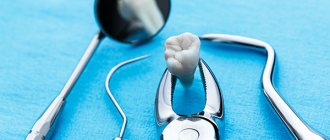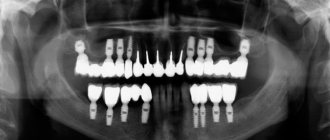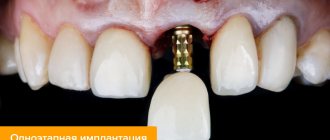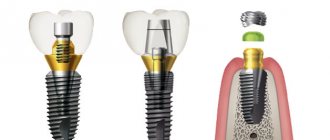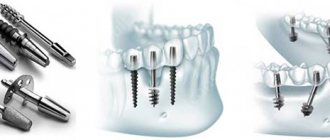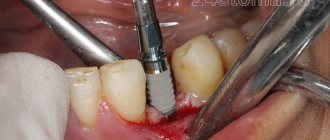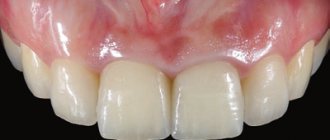Dental implantation is a modern method of restoring lost teeth, restoring chewing comfort, normal diction and an attractive smile. Its essence lies in the implantation of an artificial metal root into the jawbone, on which a crown is installed, indistinguishable in shape, appearance and function from natural teeth. But, as in all other cases, the advantages of this method have their downside.
Some people who study the issue before making a decision about which type of prosthetics to give preference suspect that something is being hidden from them, so everywhere they write only about the advantages of implantation, and about the disadvantages - briefly and indistinctly. We will try to honestly and objectively understand the pros and cons of dental implantation with you.
Dental implantation – what is it?
Patients often imagine the implant as a self-tapping screw, which is screwed into the bone, and a ceramic crown is placed on top, like a cap. And that's almost right. A dental implant is a rod that the doctor inserts under the gum and implants it into the bone. This is an artificial root, the basis of the future tooth. The second part of the structure is the aba between the base and the crown.
The implant is made in 99% of cases from a toxicologically inert titanium alloy. The popularity of the material is due to the following:
- due to the absence of a negative reaction from the body, titanium is an alternative to gold;
- upon contact with air, an oxide film is formed on the surface, facilitating survival;
- the titanium abutment connects well with composite cements and porcelain, so the result of implantation will be durable, almost indistinguishable from a real tooth with a “natural” crown;
- The titanium rod has a small thickness and weight; its installation allows you to maintain diction.
Lamellar
Plate implants
The intraosseous part is a wide thin plate with a textured surface (macrorelief in the form of a snake or corrugated structure) and holes. Such implants are practically not used, as they have more disadvantages than advantages.
Firstly, they differ in shape from the roots of natural teeth, thus they are not able to withstand and distribute the chewing load in the proper volume. Therefore, the service life is not long.
The only positive thing that can be noted is the low cost.
Benefits of dental implantation
The main advantage of dental implantation: the adjacent tooth is not ground down (prepared), the treatment is local, only in the area of the missing tooth. Also important for patients:
- An implant in the bone prevents its resorption (bone without functional load quickly atrophies).
- Artificial teeth on an implant are practically no different from your own.
- Implantation can sometimes be performed immediately after tooth extraction. This is a one-step technique.
- Implants replace missing teeth of any length.
- Implants serve as the basis for a fixed (or removable) prosthesis. Instead of 3 missing teeth, you can install 2 implants, and the middle part with a narrower chewing surface to redistribute the load - a bridge.
- In some cases, replacing a tooth with a dental implant allows you to replace a removable denture with a fixed one.
- This is the best fulcrum for a removable denture, fixation improves, and the functional value of the denture increases by 20-25%.
Important: a dental implant in the bone, unlike a tooth, is installed rigidly in the bone and has no degree of mobility. Therefore, they try not to make an “implant-bridge-tooth” design.
Dental implantation allows you to restore several teeth at once
How much does dental implantation cost?
The prices of dental implants are higher than the prices of traditional dentures only when compared “on paper” - in fact, they are quite justified. Thus, the cost of endodontic preparation of two abutment teeth and three metal-ceramic crowns is approaching the cost of a budget implant and a crown on it.
Being an alternative to prosthetics based on adjacent teeth, dental implantation costs comparable, and sometimes even cheaper, than classic bridge prosthetics. The price of implantological treatment depends on the type of implant chosen and includes the cost of the following components:
- implant;
- shaper;
- abutment;
- prosthetics on an implant.
At the same time, many factors influence the cost of the implant itself:
- prices of material for manufacturing the implant;
- work of a team of specialists who select the characteristics of the implant;
- clinical trials of products;
- processing cost;
All this is necessary for the implant to become a full-fledged tooth replacement and last as long as possible. Statistical data from world studies indicate a 98% survival rate of implants. General clinical terms of use of implants are more than 10 years. It is worth noting that during this time there was not a single rejection at the CELT clinic, and these indicators are higher than the market average!
Some implant manufacturers provide a lifetime guarantee for their products, which is the best confirmation of their high quality. Thus, with implantation, you get a complete tooth replacement, and the relatively high cost of dental implantation is justified.
Indications for implantation
Dental implants are installed when the formation of the skeleton is complete and bone growth has stopped. The upper age limit is individual. In orthodontics, there are cases where implantation was carried out for people 70-85 years old. If the patient is relatively healthy, the implant can be installed.
Implantation is indicated if:
- one tooth is missing, and next to it all are healthy (intact) or with limited defects;
- 3 or more teeth are missing in a row, up to complete absence;
- there is an allergic reaction to plastic;
- the patient has illnesses or psychological reasons due to which he cannot wear a removable denture.
Care after dental implantation
During the month after the procedure, you must follow important rules:
- Do not eat solid food.
- Avoid hot and cold drinks (any temperature changes are dangerous).
- Avoid going to the gym and swimming pool.
- Do not go to the bathhouse or sauna.
- Consume only soft and liquid foods (do not chew in the implant area).
- Brush your teeth with a soft toothbrush, using smooth movements.
- Avoid whitening toothpastes with abrasive particles.
- Make baths with an antiseptic composition.
- Lubricate the seams with protective paste before eating.
- Apply ice for the first 3-4 days in case of hematomas and swelling.
Note! After the procedure, check with your specialist for the names of all medications and the method of use to avoid complications.
Contraindications to dental implantation
Absolute contraindications:
- Acute infectious diseases.
- Systemic bone diseases (for example, autosomal dominant osteoporosis type 2), osteogenesis imperfecta, Paget's disease.
- Blood diseases (polycythemia, leukemia).
- Recent radiation therapy to the head and neck.
- Malignant and benign tumors in the upper, lower jaw and soft tissues of the oral cavity.
- Incomplete teething, incomplete growth of skull bones.
- Mental instability.
- Drug addiction and alcoholism.
Relative contraindications to dental implantation:
- Age under 20 years. The body is growing, the implant will interfere with the normal development of the jaw. In addition, there is not enough bone tissue for implantation.
- Unsatisfactory condition of the oral cavity (rehabilitation required).
- Immunological or hematological diseases, decompensated diabetes mellitus.
- Smoking more than 15-20 cigarettes per day.
- Bruxism and other parafunctional habits. After implant placement, patients are advised to use plastic mouth guards at night.
- Long-term use of antibiotics, antidepressants, anticoagulants.
- Hormonal imbalance (menopause), because During this period, the bones become more loose.
- Pregnancy, after childbirth and during lactation. Due to hormonal changes, implant installation is possible no earlier than six months after the end of breastfeeding.
When a tooth is missing for a long time, the bone tissue is resorbed. About 20 years ago this was considered a reason for refusal, but now, before implantation, surgery is performed to increase bone volume.
Bone tissue augmentation allows implants to be installed even several years after tooth loss
If we are talking about implantation in the lower jaw, it is moved to the side to prevent the threat of damage to the mandibular nerve. Due to the possible rupture of the nerve, such an operation is performed very rarely and only in a hospital.
In various forms of periodontal disease, there is no gum tightly covering the tooth. After implantation, food particles will get into the “pocket”, which will lead to inflammation of the bone tissue. Therefore, the gum is formed:
- using a flap transplant from the palate;
- by deepening the vestibule of the oral cavity between the cheek and teeth (vestibuloplasty).
Medical consultation is recommended for people with endocarditis, heart failure, pathology of the endocrine system (thyrotoxicosis, diabetes mellitus, etc.). In case of hemorrhagic diathesis, blood clotting disorders (prothrombin time, or Quick reaction index (more than 30), implant installation is carried out in a hospital setting
Reviews of dental implantation performed from patients of NK Clinic
Review from patient Pavel Review from patient Dmitry Review from patient Anna
An important feature of treatment at NKclinic is the collegial approach.
Our professionals - maxillofacial surgeons, dentists - orthopedists successfully perform total and subtotal reconstruction, returning an attractive smile even to patients who have been missing teeth for more than 20 years.
Thus, high-quality materials, constant scientific refinement of the classical method, brilliant work of surgeons, accuracy of calculations and consistency of actions allow NKclinic specialists to achieve success in 99% of cases!
Types of implants
Fixed implantable prostheses can be intraosseous or extraosseous.
Intraosseous
If you look at the implant carefully, like an orthodontist, you can distinguish not 2, but 3 parts:
- supporting;
- transgingival;
- the largest is intraosseous.
The intraosseous shape of implants is different, repeating or not repeating the shape of the tooth root. It is by these criteria that the types of dental implants are most often classified.
The shape of the intraosseous part of the prosthesis is usually made in the likeness of a tooth root. Then healing after implantation will be quick, and the chewing load will be distributed evenly in the jaw.
Lamellar
The surface of these implants is textured and (or) corrugated. There is also a macro-relief resembling a snake. To allow bone tissue to grow through the prosthesis after implantation, holes are provided in the structure. Their total area does not exceed a third of the area of the intraosseous part.
There are:
- non-separable;
- collapsible, with internal or external thread for installing the head.
Root-like
Root-shaped (endosseous) implants include:
- cylindrical. The intraosseous part is smooth, with a small surface area. It is characterized by the lowest biomechanical performance in the shear test, so the cylindrical part is made textured (bioactive coating). They are produced only collapsible;
- screw. With different thread profiles, detachable and one-piece. The surface can be smooth or rough;
- basal. Longer, with a thread at the end to secure itself in the deep layers of bone.
Mini-implants that are installed for a limited time are also classified as root-shaped. This is not to say that they are thinner or shorter than regular ones. They have a simplified and slightly lighter design for people with osteogenesis disorders.
If the root-shaped implants are not connected to each other, their rotation can occur even after a period of bone tissue regeneration. The most common causes are medical manipulation and chewing load. Therefore, their design includes anti-rotation locks (anchors, holes, longitudinal grooves, etc.).
Types of root-shaped implants
Combined
The intraosseous part of the implant can also be a combination of cylindrical and plate-shaped:
- the central part is a cylinder;
- “lateral roots” - 2 asymmetrically or symmetrically located plates.
This type also includes disc, transmandibular (designed with a bracket and 2 pins) implants. Implants of a combined form are usually detachable.
Extraosseous
For osteoporosis or osteonecrosis of the jaw, extraosseous implants are sometimes used for patients in the older age group.
Subperiosteal
These prostheses are used for the rehabilitation of patients with significant atrophy of the jaw bone tissue. They are screwed into the periosteum on the side of the gum.
Intramucosal
They are used when there is a lack of bone tissue, when the patient refuses augmentation, sometimes as a temporary measure. A small, mushroom-shaped magnet is inserted into the gum. In the future, it serves as the basis for removable orthodontic structures.
Stabilization
When implanted, the prosthesis is mounted on the natural root of the tooth, takes root well, but is considered temporary, since the “base” dries out with age, like any bone tissue.
Types of intraosseous implants
There are two types of implants: removable and non-removable.
Demountable and non-removable intraosseous implants
Permanent implants usually have an intraosseous part that extends into the head, which is in the form of a plate or screw. As a rule, operations with implants of this type are carried out using a one-stage technique. After surgery, part of the head of the intraosseous implant is visible and rises above the gum level. Direct prosthetics are most often carried out after two weeks.
Collapsible implants can be of three types:
Two-stage
(the implant consists of an intraosseous part and a head).
Three-stage
(the implant has an additional transition part located at the gum level).
Multistage
(implants may have additional parts: rings, shock absorbers, screws, caps, springs, etc.).
Collapsible implants are used for both one- and two-stage dental prosthetics.
Implantation stages
Installing an implant is a lengthy process. It is necessary for it to take root in the bone, so restoration of the dentition takes 3-6 months.
Planning and preparation
Preparation and planning of surgical intervention is:
- X-ray examination (orthopantomogram, targeted images, determination of projection distortions). A steel ball is fixed in the area of the proposed permanent prosthesis, and the length of the implant is selected based on the images.
- Determination of the thickness of the alveolar process of the upper and lower jaw using an osteometer (under anesthesia), determination of the profile of the alveolar process or part of it at the site of the proposed implant on diagnostic plaster models. Based on these data, the diameter of the implant is selected for future implantation.
- Making a diagnostic plaster model with the restoration of missing teeth (from wax or plastic), taking into account intermaxillary interaction, on the basis of which a radiopaque plastic template is created.
- Computed tomography examination. Before scanning, all removable metal dentures are removed; dental implantation will be successful if the patient is scanned motionless with his mouth slightly open.
- Creation of a 3D model of the jaw. Axial sections are obtained on a CT scan, then a computer program creates a three-dimensional image and necessarily visualizes the neurovascular bundle. Since teeth, bones, and soft tissues have different densities, based on research data, the program provides the ability to visualize the outer skin and internal structures, as well as turn off the visibility of various anatomical objects.
- Determining the type of implants and their installation sites, taking into account the qualitative and quantitative composition of bone tissue (planning the surgical stage of implantation). Taking into account the bone density readings, the optimal location for placing the implant is selected, and the distribution of chewing load is assessed. As a rule, the largest implant that can fit in a given volume is selected.
- Jaw prototyping. Checking the relationship of installed implants with antagonist teeth or opposing implants.
- Use of a surgical prototype guide. When the location of the prosthesis is strictly limited (complex anatomical conditions), the implant is positioned at a certain angle. Then, using rapid prototyping, a special surgical template is made, in which titanium cylinders are installed for drilling strictly at a given point and at the correct angle. If there is a deficiency of bone tissue, sinus lift surgery is planned.
Surgical stage
Dental implantation surgery is performed under anesthesia:
- infiltration, familiar to most local “freezing”;
- conduction, when the anesthetic is injected into the paraneural space.
Most pain during implantation is associated with the crushing of blood against the cancellous bone, as well as increased pressure on the nerve endings. To reduce pain during and after surgery, patients with high blood viscosity are advised to take instant aspirin (500 mg) 30 minutes before. before the start of the operation. In addition, when installing an implant, a constant level of bleeding is important (for this purpose, the bone bed is often washed out). Blood fills the voids between the surface of the implant and the bone, improving osseointegration (engraftment of the implant into bone tissue).
Dental implantation begins with an incision with a disposable scalpel and tilting the mucoperiosteal flaps to the sides. According to the wide flap technique, the incision is made in the middle of the alveolar ridge, and the interdental gingival papillae are carefully dissected. Thanks to this technique, there is no need to make a vertical incision, which leaves a visible scar during healing.
Another cutting technique for implantation is the use of a circular mucotome knife. This ensures minimal invasiveness (penetration of pathogenic microorganisms through the wound) and increases the resistance of the epithelium adjacent to the implant to pathogenic effects. There are no stitches for this incision. Any preparation is carried out with copious cooling with sterile saline solution.
The location and position of the prosthesis depend on the defects of the dentition and anatomical conditions. For example, when multiple implants are installed in an edentulous upper jaw, they will have a fan-shaped divergence due to the anatomical shape and inclination of the jaw itself. Read more about the features of upper teeth implantation here.
If the alveolar bone is well preserved when installing a prosthesis during implantation, several rules are followed:
- The distance between implants is at least 2-3 mm. Otherwise, the bone remodels and atrophies.
- The implants are installed at a slight angle to each other in order to evenly distribute the vertical load and reduce the concentration of excess stress.
- The tilt of the implant is mesio-distal.
- During implantation, bone tension is taken into account (the difference between the size of the prepared bone bed and the diameter of the subosseous part of the implant). The diameter of the endosseous part should be 0.2-0.5 mm larger. Then it is possible to avoid mobility of the implant and achieve rapid osseointegration.
Be sure to ensure that there is blood in the implant bed. This avoids the formation of air cavities between the bone and the implant. Understanding this fact is a guarantee of peace of mind during implantation.
Remember: dental implantation necessarily involves the formation of blood clots. This is the norm, you should not be afraid of blood.
Before inserting the implant, its surface is moistened with saline solution to reduce friction. If the implantation is one-stage, very often a gum former is immediately installed instead of an obturation screw. During two-stage implantation, mucoperiosteal flaps are hermetically sutured.
Orthopedic stage
The gingival cuff former is replaced with a support head. On the day of implantation, it is possible to manufacture and fix a provisional orthopedic structure (or 1-3 days after surgery). Then an impression is made using impression material, and then the prosthesis itself. This is done by an orthodontist who completes the restoration of the dentition.
The entire sequence of actions (cast, making a jaw model, crown or prosthesis frame) is absolutely similar to making a crown. Production time depends on the material and volume of work.
Postoperative period
On the 11th day after implantation, the sutures can be removed. In areas remote from surgery, patients keep their mouth clean and use chlorhexedine-containing products to rinse. Temporary removable dentures can begin to be worn on the 14th day, but the longer the patient goes without it, the better.
The soft lining, which gradually becomes denser, is changed after 6-8 weeks. In addition, for some implants it is necessary to tighten the transocclusal screws, so a dentist’s control is required after 6 weeks, and then after 3 - 5 months.
What are pterygoid implants?
Without a doubt, zygomatic models have taken implantology to a whole new level. But their installation is very complicated and places high demands on the training of a specialist and the equipment of dentistry. Even a minor mistake can lead to injury to the maxillary sinuses, damage to internal structures, nerve nodes, cavities, and organs of vision. In addition, implantation of a pair of Zygoma implants increases the price of prosthetics by 30-35%. Therefore, clinical studies on implantation of the upper jaw in conditions of critical bone atrophy have not stopped.
It turned out that the fixed zones of bone tissue that are not subject to destruction at any age include not only the zygomatic bone, but also the pterygoid bone. This made it possible to develop a new generation of implantation systems with minimal risk of complications during installation - pterygoid (pterygoid).
Pterygoid
(lat.) is part of the sphenoid bone of the pterygoid process, which gives its name to new models of artificial roots. Because the pterygoid process is closer, pterygoid (pterygoid) implants are shorter than zygomatic models. Their length is 15-24 mm, diameter is from 3.5 to 4.5 mm, which means:
- minimal likelihood of injuring important jaw structures when installing a titanium root;
- no risk of perforation of the maxillary sinus or damage to the orbit.
The pterygoid implant is equipped with a combined microthread with high cutting ability. A titanium root installed posteriorly in the upper jaw arch, starting from the maxillary tubercle, crosses the bone plates of the pterygoid fossa. When screwed in, the bone tissue around the artificial root is compacted, ensuring a tight fit of the surface, high primary (mechanical) and secondary (biological) stability of the implant in the jaw. The density of the pteriomaxillary (wing-maxillary) structures provides primary stability for the anchorage of the artificial root, higher than in any other part of the jaw bone.
Wing-shaped implants are developed by the Swiss company Trate AG. ROOTT P (Pterygoid) models are part of the main line of the ROOTT universal implant system. This solved the issue of sinus lift, allowing implantation to be carried out without it, even in conditions of critical maxillary bone deficiency. Because zygomatic and pterygoid models were created almost simultaneously, pterygoids are often considered a type of zygomatic implant.
Types of implantation
Based on the mutual influence of implants and oral tissues (hard, soft), several types are distinguished.
Endodonto-endosseous
Dental implantation, which uses a pin and various fixation elements in bone tissue. The pin is placed in the dental canal, so for the orthodontist, due to special manual skills, this is one of the most difficult implantations.
Endosseous
Otherwise, intraosseous. The most popular implantation, with good results of engraftment and distribution of occlusal load. The implant is inserted into the bone through a mucoperiosteal flap. The intraosseous part is made in the form:
- screw;
- plates;
- cylinder.
In addition to prosthetics of 1 tooth, this type is used in the all-on-four and all-on-six implantation method in the case of complete absence of teeth. Implants (4 or 6) will be the basis for attaching the bridge. The new All-on-3 (Trefoil) implantation method has been used since 2017, 3 implants are used, the acrylic prosthesis is permanent, manufacturing takes 1 day. Also suitable for full dental implantation.
Implants for endosseous implantation
Subperiosteal or subperiosteal
Dental implantation is recommended when alveolar bone degeneration is evident. First, an impression is made from the bone, and an implant is made from it. Then it is installed under the mucoperiosteal flap. For an orthodontic surgeon, such implantation is a top flight, since due to limited space and bone structure, it is difficult to choose a rational design that will not subsequently affect the dentition and correctly distribute the chewing load. With the advent of 3D modeling, the percentage of unsuccessful implantations has decreased, however, in difficult cases it is better to contact a dental clinic with extensive experience, since significant difficulties arise during the installation process.
Intramucosal
It is also called insert implantation. The implant resembles a button, very small. The bone is not drilled; installation occurs in the mucous tissue of the alveolar processes. The risk of installing an implant is minimal
Submucosa
In the literature for dentists, there is a second name - submucosal type. The easiest type of implantation, the risk of surgery is reduced to zero. Magnets are inserted into the transitional fold, creating a valve zone and retention (holding) of removable dentures.
Transosseous
When the atrophy of the lower jaw is clearly expressed, implants are installed through it in the intermental region and secured to the basal edge.
Research methods
From a medical point of view, stability means the absence of movement of an element, which in research is characterized by the installation torque, as well as the stability coefficient. The term “torque” is used to denote the moment of rotation resulting from the application of force to the implant during the screwing process. The higher the insertion torque, the more reliable the fixation of the prosthesis.
The simplest way to calculate the value is to use a torque wrench, the indicator arrow of which displays the turning torque. At the same time, it must be taken into account that such a measurement is inevitably associated with destruction of the artificial root ligament, limiting its diagnostic functionality.
As an alternative, various devices from foreign manufacturers are used. For example, Osstell (Sweden) and Periotest (Germany) implement a technique for measuring stability by assessing the lateral force applied to the pin during the integration process. In the first case, the principle of calculating the resonant frequency that occurs under the influence of a pulse load is used - the more stable the design, the higher the value, varying in the range of 3.5-8.5 kHz. Torque testing analyzes the time required for the implant to restore its original position after forced percussion.
Techniques
Basic surgical techniques in orthodontics include one-stage and two-stage implantation.
Two-stage
Standard implantation, which can be performed in any dental office.
Stage 1
The gum flaps are cut and moved back, clearing the bone for the implant. An axial guide channel is created with a 2-2.5 mm drill, and it is expanded with a drill of a larger diameter.
When the root portion of the implant is screw-shaped, the bone is manually threaded using taps. Then the endosseous element is screwed in using the implant lead.
If cylindrical implants are used, the bed is formed using a reamer or a special cutter. When using combined implants, first the cylindrical part is formed using fissure burs, and then preparation for the plates is carried out.
The intraosseous part of the implant is installed just below the height of the alveolar ridge. To protect against bone tissue getting inside the implant, the canal is closed with a plug, the gum flaps are raised and sutured.
Stage 2
It is carried out no earlier than 2-3 months, when it becomes clear that the root-like part of the implant is successfully engrafting. After activation of local anesthesia, the gum is excised again and the plug is removed. After flushing the canal, the upper part of the implant is screwed in. Additional incisions are sutured.
Two-stage implantation technique
One-stage
It differs from the two-stage procedure in that after implantation the entire implant protrudes into the oral cavity. It is installed by cutting the gum, or in a simplified way. This is the so-called bloodless implantation technique (no stitches are applied):
- The mucous tissue and periosteum are excised with a perforator.
- The bone bed is prepared with a drill, circular saw, or fissure bur.
- The implant is installed.
These methods of dental implantation give the same long-term results. If there are any doubts about the patient’s compliance with hygienic requirements for the cleanliness of the oral cavity, they resort to a two-stage procedure. Then the possibility decreases:
- accumulation of food plaque and bacteria on the surface of the implant;
- development of the inflammatory process;
- implant rejection.
If oral hygiene is maintained, the implant is installed in one go.
Are all implants the same?
All dental implants are made of titanium and perform the same function, but differ from each other in a number of features. According to the classification, there are prefabricated and non-separable implants, plate-shaped and root-shaped, screw and cylindrical, etc. However, patients are more interested in the prices of implants and their manufacturers. The German implants XiVE and ANKYLOS from the world famous company Dentsply Friadent are currently considered one of the best. These dental implants have been actively used by European implantologists for many years, and the appearance of these systems in Russia was a real breakthrough in domestic implantology. In terms of cost, XiVE and ANKYLOS implants are in the mid-high and high price categories, but this is quite an adequate price considering their unique properties.
draw your attention to
that the German Implant Center is the official and certified partner of all leading and world-recognized implant systems. We are one of the key partners of Dentsply in Russia precisely because of our enormous professionalism and accumulated practical experience of successful many years of work in installing implant systems of all configurations - from single implantations to total ones.
This will ensure you receive excellent service and reliable implant placement in both the short and long term.
Remember one simple truth:
With dental implantation, the implant is installed once and for life. The choice of an implant when installing it is the prerogative of the doctor, but patients should be aware of the features and advantages of a particular implant system.
How are dentures attached?
Fastening the prosthesis after implantation depends on whether it will be removable or not.
Fixed prosthetics
In this case, the prosthesis is installed by an orthodontic surgeon once. Fastening can be using locking mechanisms or dental cement.
For cement
The prosthesis is attached to the head of the implant using dental cement. There are no holes for screws - the dentition looks solid. Fast production and low costs, coupled with speed of installation, made cement fastening widespread.
Flaws:
- Such fastening poses a risk of an inflammatory process under the prosthesis if cavities remain in the cement fixation between the gum and the prosthesis.
- If it is necessary to remove the prosthesis, parts of it may be damaged.
- If the intramaxillary space is small, a small abutment is placed, the fastening becomes less reliable, and there is a risk of losing the crown.
- Difficult to remove remaining cement.
On attachments
The prosthesis is securely attached to the implants using clasps and attachments. The shapes of the locks are different; they can be located on the outside of the crown or on the inside.
Removable dentures
Removable dentures are attached differently.
Screw fixation
The prosthesis can be attached with a screw to the implant:
- to the intraosseous part;
- to the head.
If a custom abutment is made, it is secured with a lateral screw.
- Advantages of screw fixation:
- If necessary (broken, chipped abutment), it is easy to unscrew and replace.
- Does not interfere with contouring implants during soft tissue restoration.
- The reason for the screw breaking is the incorrect distribution of the chewing load; for the orthodontist this is a clear signal with a ready-made sequence of actions.
Flaws:
- Some increase in gum volume.
- Visibility of access holes (they are covered with filling material).
- A larger channel for the root part of the implant in the bone.
Push-button fastening
To secure the prosthesis, 2 implants are sufficient; push-button locks in the form of a ball or coupling are used.
Magnetic fixation
Usually magnets are soldered to the abutment. This fixation holds the prosthesis well when opening and closing the mouth, however, when chewing (horizontal movements), the prosthesis may move to the side, because the magnet cannot resist the horizontal shear force. Frequent shifts are one of the causes of complications of dental implantation, as they loosen the implant.
Beam mount
The design splints several implants (2-4), preventing their loosening. Therefore, the fixation of the prosthesis is strong, much better than a push-button one. Sometimes beam fastening is combined with telescopic or locking elements, and expanded with additional beams. Then the pressure on the gums decreases and the likelihood of inflammation decreases.
Prosthesis with beam type fastening
Telescopic system
The prosthesis with cylindrical or conical holes in the crowns is simply placed on top of 4 implants. This is one of the massive designs; when you wear it, your facial features change slightly. But with such fastening there are practically no complications of the mucous tissue under the prosthesis.
How is implantation carried out - stages of implant installation
The initial stage of implantation is the same regardless of the selected implants and their installation protocol. First, the doctor conducts a detailed diagnosis to make sure there are no contraindications. Next, the patient undergoes oral debridement to eliminate any sources of bacteria that may in the future affect the healing of the implant. Further, the algorithm for dental implantation will vary depending on the protocol.
Classic:
- The patient is given an anesthetic
- The gum is cut
- The implant is implanted into a pre-formed bed
- The wound is sutured from above with a mucosal flap
- After 2-5 months, an abutment is placed on the top of the implant, a gum former is placed on the anterior zone, then impressions are taken and a permanent prosthesis is immediately made
Single phase:
- The patient is given an anesthetic
- Use a thin instrument to make punctures in the gums
- Implants are inserted into the punctures
- Impressions are taken for a temporary prosthesis
- The next day (or every other day) - prosthetics with a temporary structure
- After 12 months - re-prosthetics - replacement of the temporary structure with a permanent one.
Which dental implantation method to choose?
The method, implant and type of prosthesis are selected individually after an examination; it is not chosen by the patient (although his wishes are listened to), but by a collegial surgeon, orthodontist and dental technician. Therefore, you need to contact specialists with many years of experience.
They take into account indications and contraindications for dental implantation based on X-ray and other studies, and simulate the implantation process using dental computer programs. However, they usually offer several options (crown - metal ceramics or zirconium dioxide, type of prosthesis, etc.), since the price of dental services depends on the materials used.
Micro-movement effect
The presence of even minimal mobility in the area of contact between the prosthesis and the bone negatively affects the results of engraftment. The mobility of the rod reduces the rate of formation of a biological relationship, destroys the structure of osteoblasts and blood vessels, and provokes the formation of fibrous tissue. One of the important conditions for prosthetics is stable and tight fixation of the base.
Parameter correlation
As the results of dental studies show, the stability coefficient depends on a number of factors, which include:
- Structure density and tissue volume with primary stability;
- The area of interaction between the implant and the surface of the bed;
- Orientation of the sensor in relation to the position of the alveolar process;
- Area of integration – mandibular implants are characterized by less stability.
Engraftment factors are analyzed and assessed as part of the clinical postoperative diagnosis, and serve as the basis for further decisions about treatment and recovery.
Fluctuations over time
Deviations in stability indicators, depending on the period elapsed from the moment of installation, are observed in most cases. Initially, the fixation reliability gradually decreases relative to the base parameter, but over time it returns to the original value. Such changes are caused by both modeling of the bone structure and smooth osseointegration, in which the prosthetic structure is gradually integrated into the tissue.
You can get visual confirmation of a decrease in mechanical stability by removing an implant installed some time ago. The first few weeks after installation, the torque required to remove the structure (reverse torque) turns out to be less than the installation torque.
However, low mechanical stability does not mean that high biological stability will not be achieved. An acceptable value is achieved regardless of primary stability. There is no need to strive for too high values of the primary coefficient. Objectively, 60-65 units is considered a sufficient indicator.
FAQ
1. Can implants fail to take root? Yes, this happens.
2. Do I need to change implants and when? Implants need to be replaced in case of fractures, breakage, chipping of the implant, transocclusal screws, suprastructures, etc. Contact your orthodontist if your implant becomes loose.
3. How much does an implant cost? The price of a high-quality prosthesis (with a crown) and labor is on average 50 thousand rubles. Economy segment 15-30 thousand rubles.
4. Which crowns are the most durable? Crowns made of zirconium dioxide and metal ceramics.
Literature:
- Dental implantation: textbook / N.E. Rural, . R.T. Bulyakov, E.I. Galieva, O.A. Gulyaeva, S.V. Viktorov, A.V. Trokhalin, I.O. Short
- Zhusev A.I., Remov Yu.A. Dental implantation. Success Criteria
- Paraskevich V.P. Dental implantology: basic theory and practice
- Sudnev I., Mikhailov I., Goldstein E. Dental implantation. New level of prosthetics
- Trezubov V.N., Shteingard M.Z., Mishnev L.M. Orthopedic dentistry. Applied materials science
Moscow metro station Zvezdnaya, Danube Avenue, 23
Where to go for dental implantation in Moscow
A dental implant is not an artificial tooth, as many people mistakenly believe, but an artificial titanium root the size of a natural tooth root. An artificial tooth placed on it is called a crown. However, the number of implants does not necessarily correspond to the number of missing teeth and fixed crowns. In many cases, it is possible to perform implantation at several points and fix several missing teeth on supports. Sometimes even four dental implants are enough to secure the entire prosthesis on them.
The first step to performing an implantation operation is a consultation with a specialist, during which the doctor will conduct a thorough interview, determine the set of necessary tests, and select the optimal protocol for dental implantation in a particular case. During the consultation, patients receive full information both about the procedure itself and about the appropriate preparation and subsequent actions. To compare the cost of services, we suggest that you familiarize yourself with the approximate prices for dental implantation in some dentists in Moscow.
| Name | Clinic address | Service cost |
| ROOTT |
|
|
| Shandora | Moscow, Kolpachny lane, 6, building 4. |
|
| Dentistry Grand Smile | Moscow, st. Miklouho-Maklaya 43 (metro station Belyaevo, Yugo-Zapadnaya, Kaluzhskaya) | Prices for dental implantation from 30,000 rubles (MIS system) to 70,000 rubles (Nobel) |
| Dentistry City Dent | Moscow, st. Novocheremushkinskaya, 57 | Implantation of one tooth with the Astra Tech system – 52,000 rubles |
| Dentistry Vita-Stom |
| Implantation of one tooth with the Straumann system (Switzerland) – from 32,000 rubles. |
Choosing the right doctor and clinic is an important point. But the patient's behavior can significantly contribute to the success of the treatment, so it is necessary to strictly follow the doctor's instructions after the procedure. In particular, to minimize the possibility of complications, the patient should:
- avoid physical activity
- apply cold compresses to the face near the operated area
- use pharmacotherapy strictly as prescribed by the doctor,
- eat only cold semi-liquid foods for three days, and semi-liquid foods for the next 2 weeks
- Do not touch the operated area with your tongue or fingers.
During the first 2 weeks, strictly follow the hygiene recommendations. If even the slightest alarming symptom appears, the patient should contact an implantologist as soon as possible.
Other jobs
Dental surgeons and orthopedic surgeons
The Orange Clinic dentistry employs experienced dental surgeons:
- Ontoboev Andrey Nikolaevich - surgeon, specialist in prosthetics on implants, plate, clasp, covering orthopedic structures, dental restoration using all-, gold- and metal-ceramic restorations;
- Zykin Dmitry Vasilievich - surgeon in the field of implantation with delayed and immediate loading; carries out bone tissue growth (including using membranes from the patient’s blood plasma):
- Patashyan Armen Zavenovich - specialist in prosthetics on implants, treatment of diseases of the teeth and oral cavity;
- Chebykin Vladimir Georgievich is a specialist in prosthetics on implants and other modern methods of orthopedic treatment.
All Orange Clinic specialists have extensive experience in installing implants for further dental prosthetics and regularly improve their skills in the field of surgery and detailed implantology.
